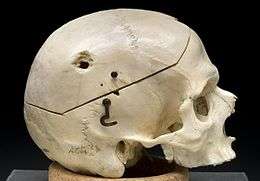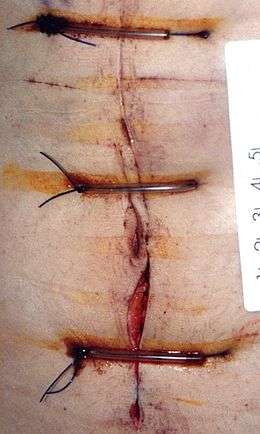Ballistic trauma

Ballistic trauma, or gunshot wound (GSW), is a form of physical trauma sustained from the discharge of arms or munitions.[1] The most common forms of ballistic trauma stem from firearms used in armed conflicts, civilian sporting, recreational pursuits and criminal activity.[2] Ballistic trauma can be fatal or cause long-term consequences.
Destructive effects

The degree of tissue disruption caused by a projectile is related to the size of the temporary versus permanent cavity it creates as it passes through tissue.[3] The extent of cavitation, in turn, is related to the following characteristics of the projectile:
- Kinetic energy: KE = mv2/2 (where m is mass and v is velocity). This helps to explain why wounds produced by missiles of higher mass and/or higher velocity produce greater tissue disruption than missiles of lower mass and velocity.
- Yaw
- Deformation
- Fragmentation
The immediate damaging effect of a gunshot wound is typically severe bleeding, and with it the potential for hypovolemic shock, a condition characterized by inadequate delivery of oxygen to vital organs. In the case of traumatic hypovolemic shock, this failure of adequate oxygen delivery is due to blood loss, as blood is the means of delivering oxygen to the body's constituent parts. Devastating effects can result when a bullet strikes a vital organ such as the heart or lungs, or damages a component of the central nervous system such as the spine or brain.
Common causes of death following gunshot injury include exsanguination, hypoxia caused by pneumothorax, catastrophic injury to the heart and larger blood vessels, and damage to the brain or central nervous system. Additionally, gunshot wounds typically involve a large degree of nearby tissue disruption and destruction due to the physical effects of the projectile. Non-fatal gunshot wounds frequently have severe and long-lasting effects,[4] typically some form of major disfigurement and/or permanent disability.
Gunshot injuries can vary widely from case to case since the location of the injury can be in any part of the body, with wide variations in entry point. Also, the path and possible fragmentation of the bullet within the body is unpredictable. The study of the dynamics of bullets in gunshot injuries is called terminal ballistics.
As a rule, all gunshot wounds are considered medical emergencies that require immediate treatment. Hospitals are generally required to report all gunshot wounds to police.[5]
Origins of medical treatment
Hieronymus Brunschwig argued that infection of gunshot wounds was a result of poisoning by gunpowder, which provided the rationale for cauterizing wounds. Ambroise Paré wrote in his 1545 book, The Method of Curing Wounds Caused by Arquebus and Firearms, that wounds should be sealed rather than cauterized.[6][7] John Hunter argued that infection was not caused by poisoning.
Until the 1880s, the standard practice for treating a gunshot wound called for physicians to insert their unsterilized fingers into the wound to probe and locate the path of the bullet.[8] Surgically opening abdominal cavities to repair gunshot wounds,[9] germ theory, and Joseph Lister's technique for antiseptic surgery using diluted carbolic acid, first demonstrated in 1865, had not yet been accepted as standard practice. For example, sixteen doctors attended to President James A. Garfield after he was shot, and most probed the wound with their fingers or dirty instruments.[10] Historians agree that massive infection was a significant factor in Garfield's death.[8][11]
At almost the same time, in Tombstone, Arizona Territory, on 13 July 1881, George E. Goodfellow performed the first laparotomy to treat an abdominal gunshot wound.[12]:M-9 Goodfellow pioneered the use of sterile techniques in treating gunshot wounds,[13] washing the patient's wound and his hands with lye soap or whisky.[14] He became America's leading authority on gunshot wounds[15] and is credited as the United States' first civilian trauma surgeon.[16]
Surgical advances
Wilhelm Röntgen's discovery of X-rays in 1895 led to the use of radiographs to locate bullets in wounded soldiers.[6]
Survival rates for gunshot wounds improved during the Korean and Vietnam Wars, due in part to helicopter evacuation, along with improvements in resuscitation and battlefield medicine.[6][17] Similar improvements were seen in the trauma practices during the Iraq War.[18] Some military trauma care practices are disseminated by citizen soldiers who return to civilian practice.[6][19][20] One such practice is to transfer major trauma patients to an operating theater as soon as possible, to stop internal bleeding. Within the United States, the survival rate for gunshot wounds has increased, leading to apparent declines in the gun death rate in states that have stable rates of gunshot hospitalizations.[21][22][23][24]
See also
- Battlefield medicine
- Emergency medicine
- Hydrostatic shock
- Multiple gunshot suicide
- Penetrating trauma
- Stopping power
- Vincent Di Maio
- Stab wound
References
| Wikimedia Commons has media related to Gunshot wounds. |
- ↑ Mahoney, P. F., et al. (2004). Section 1 : Introduction, Background and Science p4
- ↑ Mahoney, P. F., et al. (2004). The International Small Arms Situation p6
- ↑ Wound Ballistic Research of the Past Twenty Years: A Giant Step Backwards
- ↑ "My story -the leg wounds".
- ↑ Ovens, Howard (13 April 2004). "Why mandatory reporting of gunshot wounds is necessary: A response from the OMA's Executive of the Section on Emergency Medicine". CMAJ. 170 (8): 1256–1257. doi:10.1503/cmaj.1040464. PMC 385357
 . PMID 15078849 – via www.cmaj.ca.
. PMID 15078849 – via www.cmaj.ca. - 1 2 3 4 Manring MM, Hawk A, Calhoun JH, Andersen RC (2009). "Treatment of war wounds: a historical review.". Clin Orthop Relat Res. 467 (8): 2168–91. doi:10.1007/s11999-009-0738-5. PMC 2706344
 . PMID 19219516.
. PMID 19219516. - ↑ Pruitt, Basil A. (2006). "Combat Casualty Care and Surgical Progress". Annals of Surgery. 243 (6): 715–729. doi:10.1097/01.sla.0000220038.66466.b5. ISSN 0003-4932. PMC 1570575
 . PMID 16772775.
. PMID 16772775. - 1 2 Schaffer, Amanda (25 July 2006). "A president felled by an assassin and 1880's medical care". New York Times. New York, New York. Retrieved 29 April 2016.
- ↑ Crane, Michael A. (2003). "Dr. Goodfellow: gunfighter's surgeon" (PDF). Retrieved 10 March 2013.
- ↑ "The death of President Garfield, 1881". Retrieved 11 March 2013.
- ↑ Rutkow, Ira (2006). James A. Garfield. New York: Macmillan Publishers. ISBN 978-0-8050-6950-1. OCLC 255885600.
- ↑ Charles E. Sajous, ed. (1890). Annual of the Universal Medical Sciences And Analytical Index 1888-1896. 3. Philadelphia: F.A. Davis Company.
- ↑ "Come face to face with history" (PDF). Cochise County. pp. 8–9.
- ↑ Edwards, Josh (2 May 1980). "George Goodfellow's medical treatment of stomach wounds became legendary". The Prescott Courier. pp. 3–5.
- ↑ "Dr. George Goodfellow". Retrieved 8 March 2013.
- ↑ "Tombstone's doctor famous as surgeon". The Prescott Courier. 12 September 1975. Retrieved 11 March 2013.
- ↑ "Chapter 3 - Medical Support 1965-1970".
- ↑ Service, Lee Bowman, Scripps Howard News (16 March 2013). "Iraq War 10 year anniversary: Survival rate of wounded soldiers better than previous wars".
- ↑ "Military medical techniques saving lives at home - News stories - GOV.UK".
- ↑ "The role of the gun in the advancement of medicine". 8 January 2015.
- ↑ Jena, Anupam B.; Sun, Eric C.; Prasad, Vinay (2014). "Does the Declining Lethality of Gunshot Injuries Mask a Rising Epidemic of Gun Violence in the United States?". Journal of General Internal Medicine. 29 (7): 1065–1069. doi:10.1007/s11606-014-2779-z. ISSN 0884-8734. PMC 4061370
 . PMID 24452421.
. PMID 24452421. - ↑ "Lower murder rate linked to medical advance, not less violence".
- ↑ Fields, Gary; McWhirter, Cameron (8 December 2012). "In Medical Triumph, Homicides Fall Despite Soaring Gun Violence" – via Wall Street Journal.
- ↑ http://www.universitychurchchicago.org/wp-content/uploads/2013/06/Murder-and-Medicine.pdf
Bibliography
- Mahoney, P. F., Ryan, J., Brooks, A. J., Schwab, C. W. (2004) Ballistic Trauma – A practical guide 2nd ed. Springer:Leonard Cheshire
- Krug E. E., ed. World Report on Violence and Health. Geneva: World Health Organization; 2002.
- World Health Organization (WHO). Small arms and global health. Paper prepared for SALW talks. Geneva: July 2001.